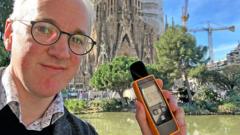A new investigation reveals that noise pollution is significantly impacting health, leading to serious conditions like heart disease, diabetes, and even dementia due to constant exposure to disruptive sounds.
The Silent Killer: How Noise Pollution is Undermining Our Health

The Silent Killer: How Noise Pollution is Undermining Our Health
Exploring the alarming effects of noise on physical and mental well-being
Noise pollution surrounds us, forming an invisible menace that quietly erodes our health. This cacophony, often ignored, is linked not just to hearing loss, but to dire health concerns like heart attacks, type 2 diabetes, and emerging evidence connecting it to dementia. Prof. Charlotte Clark from St George's, University of London, warns that this issue is a looming public health crisis that warrants urgent attention.
On a journey to uncover the implications of noise, I joined Prof. Clark in a silent sound lab, where my physiological response to various sound stimuli would be measured. Equipped with a smartwatch-like device that tracked my heart rate and perspiration, we explored how different sounds influenced my emotional and physical responses. Traffic noise, particularly from Dhaka, Bangladesh—reported as the noisiest city globally—provoked immediate stress and agitation, as reflected in my increased heart rate. Interestingly, joyful sounds, such as children's laughter, elicited a calm response, demonstrating the deep connection between sound and emotional well-being.
Prof. Clark elucidated that our ears never truly rest, even during sleep, as the brain continues to process sounds, activating stress responses that accumulate over time and can lead to chronic health conditions. The increasingly noisy environments we inhabit—especially those marked by heavy traffic, social activities, and urban living—place a significant toll on our health. In densely populated Barcelona, for instance, noise is a constant presence, evidenced by residents like Coco, who is under constant siege from late-night gatherings.
According to Dr. Maria Foraster, noise-related health impacts in Europe contribute to approximately 12,000 premature deaths annually, primarily from traffic noise, which poses the most considerable risk due to its ubiquity. The World Health Organization highlights a concerning relationship between noise levels and health risks, noting that an ideal environment for heart health should not exceed 53 decibels, a threshold often breached in urban areas.
Efforts to attenuate noise pollution, such as Barcelona's "superblock" initiative, aimed to repurpose city streets for pedestrian-friendly areas, cutting overall noise levels and potentially reducing health risks. However, very few such initiatives have been realized despite substantial projected benefits.
As urban populations swell, so too does the challenge of noise control. In Dhaka, artist Momina Raman Royal has garnered attention through silent protests addressing the city's horn-honking epidemic, manifesting the public's growing frustration. Political officials have begun to respond, recognizing the urgent need for reforms to mitigate noise levels and safeguard public health.
While the road to a quieter, healthier environment is fraught with challenges, embracing moments of tranquillity becomes increasingly necessary in our increasingly loud world. As shared by Dr. Masrur Abdul Quader, noise stands as a "silent killer and a slow poison," urging us all to seek refuge from the din of daily life.
On a journey to uncover the implications of noise, I joined Prof. Clark in a silent sound lab, where my physiological response to various sound stimuli would be measured. Equipped with a smartwatch-like device that tracked my heart rate and perspiration, we explored how different sounds influenced my emotional and physical responses. Traffic noise, particularly from Dhaka, Bangladesh—reported as the noisiest city globally—provoked immediate stress and agitation, as reflected in my increased heart rate. Interestingly, joyful sounds, such as children's laughter, elicited a calm response, demonstrating the deep connection between sound and emotional well-being.
Prof. Clark elucidated that our ears never truly rest, even during sleep, as the brain continues to process sounds, activating stress responses that accumulate over time and can lead to chronic health conditions. The increasingly noisy environments we inhabit—especially those marked by heavy traffic, social activities, and urban living—place a significant toll on our health. In densely populated Barcelona, for instance, noise is a constant presence, evidenced by residents like Coco, who is under constant siege from late-night gatherings.
According to Dr. Maria Foraster, noise-related health impacts in Europe contribute to approximately 12,000 premature deaths annually, primarily from traffic noise, which poses the most considerable risk due to its ubiquity. The World Health Organization highlights a concerning relationship between noise levels and health risks, noting that an ideal environment for heart health should not exceed 53 decibels, a threshold often breached in urban areas.
Efforts to attenuate noise pollution, such as Barcelona's "superblock" initiative, aimed to repurpose city streets for pedestrian-friendly areas, cutting overall noise levels and potentially reducing health risks. However, very few such initiatives have been realized despite substantial projected benefits.
As urban populations swell, so too does the challenge of noise control. In Dhaka, artist Momina Raman Royal has garnered attention through silent protests addressing the city's horn-honking epidemic, manifesting the public's growing frustration. Political officials have begun to respond, recognizing the urgent need for reforms to mitigate noise levels and safeguard public health.
While the road to a quieter, healthier environment is fraught with challenges, embracing moments of tranquillity becomes increasingly necessary in our increasingly loud world. As shared by Dr. Masrur Abdul Quader, noise stands as a "silent killer and a slow poison," urging us all to seek refuge from the din of daily life.





















